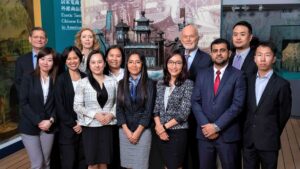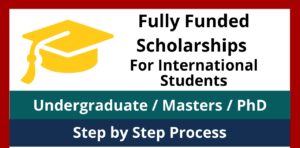Common Mistakes to Avoid When Applying for Scholarships
Scholarships are one of the best ways to finance your education, especially for international students or those pursuing advanced degrees.

However, the scholarship application process can be highly competitive. To maximize your chances of success, it’s crucial to avoid common mistakes that could prevent you from standing out as a strong candidate.
In this blog post, we will explore the most frequent mistakes students make during the scholarship application process and provide practical tips to help you avoid them.
Whether you are applying for a fully funded undergraduate, master’s, or PhD scholarship, this guide will help ensure you submit a strong application.
1. Failing to Read and Understand the Eligibility Criteria
Before even starting your scholarship application, the most crucial step is to carefully review the eligibility criteria.
Scholarship committees receive countless applications, and they often have specific guidelines regarding who qualifies for their funding.
Common Mistake:
Many applicants overlook or misunderstand the eligibility requirements, leading them to apply for scholarships they don’t qualify for.
This mistake can result in wasted time, effort, and energy.
How to Avoid This Mistake:
Read the requirements thoroughly: Take the time to read all the eligibility conditions listed on the scholarship page.
This includes academic qualifications, language proficiency, country of origin, study field, and other specific conditions.
Match your qualifications: Ensure you meet all the listed qualifications before applying.
If you’re unsure about any requirement, it’s better to seek clarification or avoid applying rather than risking disqualification.
2. Missing the Deadline
Missing a scholarship deadline is a common and avoidable mistake that can instantly eliminate your chances. Many students assume they have more time than they actually do and fail to submit their applications on time.
Common Mistake:
Missing the scholarship deadline or submitting documents late due to poor planning.
How to Avoid This Mistake:
Set multiple reminders: Mark the deadline on your calendar, and set up digital reminders for a week or even a month before the actual due date.
Submit early: Aim to complete your application at least a few days before the deadline. This will give you extra time in case you encounter any unexpected issues or need to make last-minute changes.
3. Submitting Incomplete or Incorrect Documents
Scholarship applications often require multiple documents, such as transcripts, recommendation letters, essays, and proof of language proficiency. Submitting incomplete or incorrect documents can lead to immediate disqualification or delays in processing.
Common Mistake:
Forgetting to include key documents, submitting incorrect files, or submitting outdated versions of transcripts or recommendation letters.
How to Avoid This Mistake:
Double-check your documents: Before submitting, verify that you have included all required documents. Prepare a checklist to ensure nothing is missing.
Ensure correctness: Make sure that your documents are up-to-date and formatted correctly according to the scholarship guidelines (e.g., PDF, Word document).
Review documents thoroughly: Proofread your essays, CV, and other documents to avoid typos, grammatical errors, or factual inaccuracies

4. Not Personalizing the Application or Essays
Scholarship committees review many applications and are looking for students who show genuine passion and alignment with their mission. Copy-pasting generic responses or essays that lack a personal touch can make your application stand out in a negative way.
Common Mistake:
Using generic responses that don’t reflect your unique experiences or reasons for applying.
How to Avoid This Mistake:
Tailor your application: Write essays that reflect your personal journey, goals, and motivations.
Show how you meet the scholarship’s objectives and explain why you’re a great fit.
Highlight your strengths: Emphasize how your academic achievements, leadership skills, or community involvement align with the scholarship’s values.
5. Ignoring the Scholarship’s Focus and Purpose
Each scholarship is created with a specific focus, whether it’s for students studying a particular field, coming from a specific region, or demonstrating particular skills. If you fail to align your application with the scholarship’s objectives, your chances of winning diminish.
Common Mistake:
Failing to connect your academic interests or career goals with the specific focus of the scholarship.
How to Avoid This Mistake:
Understand the scholarship’s mission: Research the scholarship thoroughly and understand its purpose. Does it focus on a specific field like STEM, human rights, or sustainability? Tailor your personal statement or essay to reflect this focus.
Show alignment: Clearly explain how the scholarship will help you achieve your goals and how you plan to contribute to the field or cause that the scholarship supports.
6. Overlooking the Importance of Letters of Recommendation
Recommendation letters play a pivotal role in many scholarship applications. They provide insight into your character, academic performance, and potential for success. Submitting weak or generic letters can undermine your application.
Common Mistake:
Submitting a generic or poorly written recommendation that doesn’t provide detailed examples of your skills or accomplishments.
How to Avoid This Mistake:
Choose the right recommenders: Select individuals who know you well and can speak to your strengths, accomplishments, and potential. This could include professors, mentors, or employers.
Provide guidance: Give your recommenders a brief outline of the scholarship and why you’re applying. Share specific achievements and goals that will help them write a personalized letter that highlights your qualifications.
7. Not Proofreading Your Application
When you’re busy with multiple applications, it’s easy to overlook the details. However, submitting an application with typos, grammatical errors, or awkward phrasing can severely affect your chances of success.
Common Mistake:
Submitting an application without reviewing it for spelling mistakes, grammatical errors, or inconsistent formatting.
How to Avoid This Mistake:
Proofread: Always proofread your application thoroughly. If possible, ask a friend, teacher, or mentor to review it for errors you may have missed.
Use tools: Utilize grammar-checking tools like Grammarly or Hemingway Editor to help catch any language or formatting mistakes.
8. Focusing Only on One Scholarship
Relying on one scholarship opportunity is risky, especially considering how competitive some programs can be. While it’s important to put effort into each application, diversifying your scholarship applications is crucial for increasing your chances of winning.
Common Mistake:
Focusing all your attention on one scholarship and not applying for others.
How to Avoid This Mistake:
Apply for multiple scholarships: Research various scholarship opportunities that you’re eligible for and apply to as many as possible. This gives you multiple chances to secure funding.
Diversify your applications: Apply to scholarships that cater to different fields, study levels, or specific skills to increase your opportunities.
9. Not Following the Application Instructions
Each scholarship has specific application instructions that must be followed precisely. Failure to adhere to these guidelines can result in disqualification or your application being ignored.
Common Mistake:
Not following the specific instructions about how to format your application, where to submit it, or what materials are required.
12 canada resources that will help you get scholarship
How to Avoid This Mistake:
Read the instructions carefully: Pay close attention to the scholarship guidelines, such as file formats, word count limits, or submission methods.
Double-check everything: Before submitting your application, ensure that all instructions have been followed to the letter.

Conclusion: The Path to a Successful Scholarship Application
Avoiding these common mistakes will significantly increase your chances of receiving a scholarship.
Be thorough, plan ahead, and personalize your application to make the most of the opportunities available.
Whether you’re applying for a fully funded scholarship for an undergraduate, master’s, or PhD program, following these tips will ensure that you put forth your best effort.
By focusing on the details, tailoring your application to each scholarship’s purpose, and submitting all necessary documents on time, you can stand out among the many applicants and secure the funding you need to achieve your academic goals.
Are you ready to start your scholarship application journey? Begin by researching scholarships in your field of study, gather your materials, and submit your applications on time.





